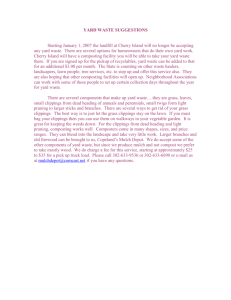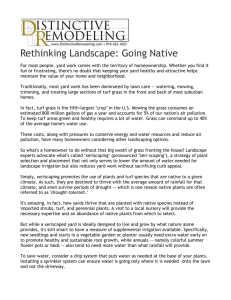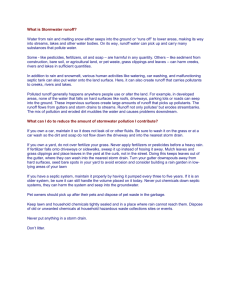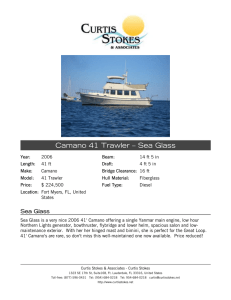Issue 54: April 2009
advertisement
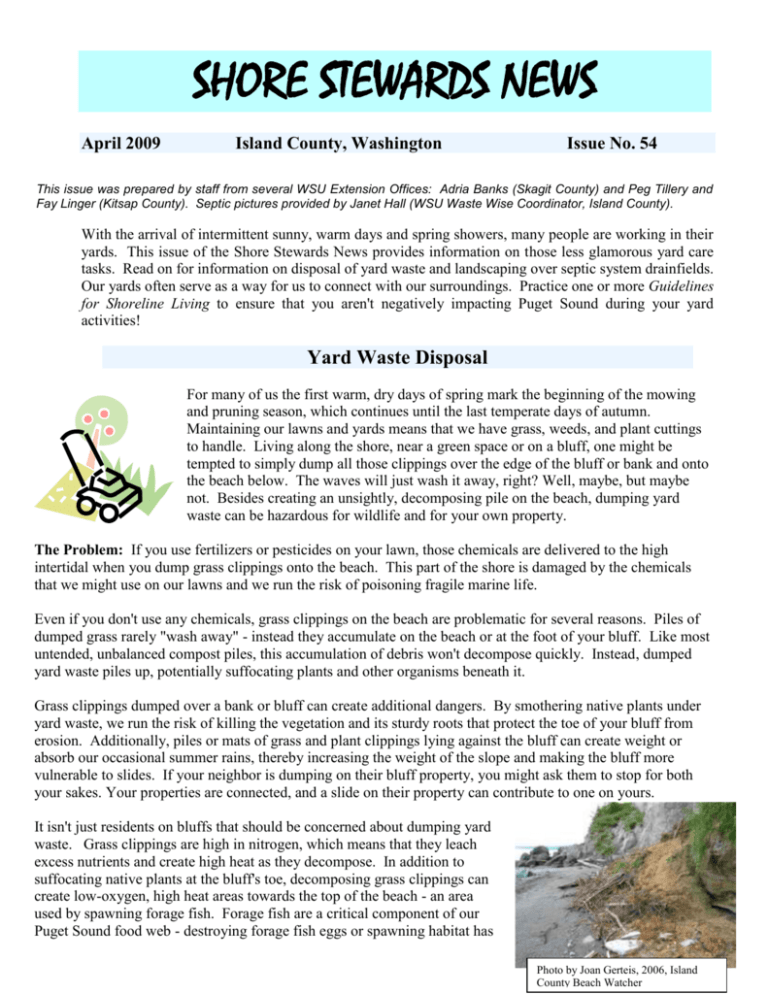
SHORE STEWARDS NEWS April 2009 Island County, Washington Issue No. 54 This issue was prepared by staff from several WSU Extension Offices: Adria Banks (Skagit County) and Peg Tillery and Fay Linger (Kitsap County). Septic pictures provided by Janet Hall (WSU Waste Wise Coordinator, Island County). With the arrival of intermittent sunny, warm days and spring showers, many people are working in their yards. This issue of the Shore Stewards News provides information on those less glamorous yard care tasks. Read on for information on disposal of yard waste and landscaping over septic system drainfields. Our yards often serve as a way for us to connect with our surroundings. Practice one or more Guidelines for Shoreline Living to ensure that you aren't negatively impacting Puget Sound during your yard activities! Yard Waste Disposal For many of us the first warm, dry days of spring mark the beginning of the mowing and pruning season, which continues until the last temperate days of autumn. Maintaining our lawns and yards means that we have grass, weeds, and plant cuttings to handle. Living along the shore, near a green space or on a bluff, one might be tempted to simply dump all those clippings over the edge of the bluff or bank and onto the beach below. The waves will just wash it away, right? Well, maybe, but maybe not. Besides creating an unsightly, decomposing pile on the beach, dumping yard waste can be hazardous for wildlife and for your own property. The Problem: If you use fertilizers or pesticides on your lawn, those chemicals are delivered to the high intertidal when you dump grass clippings onto the beach. This part of the shore is damaged by the chemicals that we might use on our lawns and we run the risk of poisoning fragile marine life. Even if you don't use any chemicals, grass clippings on the beach are problematic for several reasons. Piles of dumped grass rarely "wash away" - instead they accumulate on the beach or at the foot of your bluff. Like most untended, unbalanced compost piles, this accumulation of debris won't decompose quickly. Instead, dumped yard waste piles up, potentially suffocating plants and other organisms beneath it. Grass clippings dumped over a bank or bluff can create additional dangers. By smothering native plants under yard waste, we run the risk of killing the vegetation and its sturdy roots that protect the toe of your bluff from erosion. Additionally, piles or mats of grass and plant clippings lying against the bluff can create weight or absorb our occasional summer rains, thereby increasing the weight of the slope and making the bluff more vulnerable to slides. If your neighbor is dumping on their bluff property, you might ask them to stop for both your sakes. Your properties are connected, and a slide on their property can contribute to one on yours. It isn't just residents on bluffs that should be concerned about dumping yard waste. Grass clippings are high in nitrogen, which means that they leach excess nutrients and create high heat as they decompose. In addition to suffocating native plants at the bluff's toe, decomposing grass clippings can create low-oxygen, high heat areas towards the top of the beach - an area used by spawning forage fish. Forage fish are a critical component of our Puget Sound food web - destroying forage fish eggs or spawning habitat has Photo by Joan Gerteis, 2006, Island County Beach Watcher the potential for severe repercussions for salmon, seabirds, and marine mammals. Additionally, excess nutrients leaching out of our green waste can lead to algal blooms. As the algae or phytoplankton use up the excess nutrients, they start to decompose, and decomposition uses up oxygen, creating low oxygen conditions harmful to marine life. Some Options: Clearly our yard waste doesn't belong on the beach or in Puget Sound. One option is to reduce or eliminate lawn by planting native plants that don’t need mowing and only minimal trimming. This might be especially attractive to bluff property landowners as a wide buffer of low-growing natives between your lawn or garden and the bluff edge won’t block your view and will also be a low-maintenance, water-free zone that you won't have to mow and will also keep the weight from excess watering away from the bluff. If lawn reduction and native plant buffers aren't an option, the easiest thing to do is to use a mulching mower. Set your mower higher (1-2"), mow frequently, and the mower pulverizes and shoots the grass down to the soil. This fertilizes and waters your lawn (since grass is over 90% water), and you save time and energy by not bagging or disposing of clippings. If this won't work, you can create your own compost pile, preferably away from the bluff, which would also supply you with compost for your garden or other yard plants. Alternatively, many counties now offer yard waste recycling for reasonable monthly fees. For those of us in more rural areas, these door-to-door programs might not be available, but check with your local Solid Waste facility to verify that you can deliver and dispose of your yard waste there. Landscaping Septic Drainfields and Mounds How to landscape a drain field and around mounds is an often asked question by septic system owners. The drainfield size and shape varies based on the type of system you have. Regardless of the type, a good rule of thumb for landscaping over drain fields is to use shallow rooted, drought tolerant plants with non-dense roots. Ongoing watering is not encouraged. Here are some recommendations to consider. Vegetables: One of the most common questions about landscaping drainfields is "Can I plant a vegetable garden over the drainfield?" The answer is, “It is not recommended.” Vegetables often need daily watering and excess water in the soil reduces its ability to filter and treat wastewater. Also, if the tank is not functioning properly the drainfield could contaminate the vegetables and make them unsafe to eat. Conventional / Gravity Fed System Drainfield Tree and shrub set backs: Large trees and shrubs should be avoided over the entire area and setbacks for these larger plants should be followed. Trees and large shrubs should be at least 30 feet away from the drain field. One reason is to prevent tree roots from getting into and breaking the pipes or even into the septic tank. Lawns: Grasses with their shallow root systems are the simplest and most frequently recommended plantings over the drainfield. Choose a traditional lawn (remember to fertilize only in the spring and fall, if at all), or choose an unmowed meadow. You may include permeable pathways, garden ornaments, tables and benches. If a mowed lawn is your priority, use grass seed mixes suitable for our Northwest climate, and mixed specifically for sun or shade depending on the site of the leach field. Meadows: Wildflower meadows are frequently suggested for drainfields but in reality they are difficult to maintain. Perennial seeds in the meadow mixes, such as lupines, tend to take over and the annual seeds included 2 in with the mixes do not always sustain themselves for more than a year. If you wish to try a wildflower meadow mix make sure it is for the Northwest and does not contain seeds or plants on the Washington State Noxious Weed list. You may want to try one of the various "eco" lawn mixes available through Northwest nurseries and catalogs that are a blend of grasses and wildflowers that require a minimum of water, fertilizer and mowing. Perennial Gardens: In sunnier locations, perennial gardens can be created with mixes of ornamental grasses of different heights and can be inter-planted with ground covers, small bulbs, and sun loving perennials as well as smaller, shallow rooted shrubs. Some sun loving perennials are daffodils, narcissus, tulips, daylilies, crocosmia, lavenders, heathers, astilbes, and meadow rue (Thalictrum aquiligiifolium). Some shade tolerant options include Solomon's seal (Polygonatum biflorum), trillium (Trillium sp.), Pachysandra (Pachysandra terminalis), Wintergreen (Gaultheria procumbens), Lily-of-the-valley (Convallaria majalis), and False lily-of-the-valley (Maianthemum dilatatum). Ferns can be used in shadier locations, but the larger ones, like Sword and Giant Chain Fern should be avoided. Ornamental Grasses: The larger grasses are known to harm septic fields. Avoid Miscanthus, Pampas grass and any Bamboo. Make your selections from the many smaller varieties, evergreen or deciduous. Glendon Biofilter Mounds Mound Gardening: Glendon Biofilters consist of a septic tank, pump tank and above ground mounds over the basins used to filter the effluent from the tanks. These mounds could be called "conspicuous" and perhaps "challenging" to landscape. Many homeowners block off the view of the mound area with hedge plantings or decorative fencing. Care should be taken that the plants chosen for a hedge should be kept about 4 feet away from the mounds to allow for maintenance of both the mounds and the hedge. The plants chosen should not have aggressive runners or roots. Avoid hedges of any of the native evergreen trees such as Western Red Cedar and Hemlock. Laurels should also be avoided. Use more "friendly" plants such as California Wax myrtle (Myrica californica) or smaller, slower growing boxwoods. The wax myrtle will grow tall and may need to be pruned. It is desirable to plant the mounds with a ground cover type of plant to prevent erosion of the sand and to help them blend into the landscaping. There are many ground cover plants available in the nurseries and their tags will tell which are suitable for sun or shade. Examples of suitable plants for ground cover on the mounds are Coastal strawberry (Frageria chiloensis); Kinnikinnick (Arctostaphylos uva-ursi); Wintergreen (Gaultheria procumbens); Creeping rubus (Rubus pentalobus); Sweet Woodruff (Galium odoratum) and Dwarf periwinkle (Vinca minor). Resources For more information on Septic Systems visit these websites: www.dol.wa.gov - WA State Dept of Licensing - to find out if your designer/engineer is authorized to provide design services www.wsg.washington.edu - Washington Sea Grant Program - click on Septic Sense for information regarding onsite sewage systems www.doh.wa.gov - WA State Department of Health - Search for "Wastewater" http://www.islandcounty.net/health/liquid/HOST.htm - Island County Public Health information on new Island County septic regulations, and how to register for classes to learn how to inspect your system. 3 Events/Activities Recycle Your Old Tires at Reduced Cost on May 9th - There will be a reduced cost tire recycling event on both Whidbey and Camano on Sat., May 9, 10 am - 2 pm. On Whidbey, go to Coupeville Solid Waste Facility, 20018 SR 20, behind recycling facility. On Camano, look for signs on Can Ku Road, behind the CASA Animal Shelter on N. East Camano Drive. You can get rid of those old tires taking up room in your yard and garage. You'll also be ridding your property of a mosquito breeding ground: the puddle in one tire can breed up to 25,000 mosquitoes in a season! Volunteers from WSU Waste Wise and WSU Beach Watchers will be accepting tires at a greatly reduced rate from the regular Transfer Station prices. Tires should be reasonably clean, not full of dirt or Styrofoam. Passenger and light truck tires are accepted for $2.25 each off rim, and $4.00 on rim. Please call for arrangements if you have a load of over 100 tires. No large truck tires, tractor tires, motorcycle tires or airplane tires accepted, sorry. For additional information on Whidbey, call Janet Hall at (360) 678-7974, or email halljn@wsu.edu . On Camano, call Scott Chase, (360) 387-3443, ext 258, or email schase@wsu.edu. Grow Your Own Shellfish, May 27th - Want to learn how to grow your own shellfish? Come to an informational presentation by Bill Dewey, Public Affairs Manager for Taylor Shellfish Company and owner of Chuckanut Shellfish, Inc. This discussion is free and will take place at 7:00 pm on Wednesday, May 27th, at the Camano Community Center, 141 N. E. Camano Drive, Camano Island. Questions or directions: (360) 387-3443, ext. 258 ……………………………………………………………………………………………………………………… This product was funded through a grant from Washington State Department of Ecology. While these materials were reviewed for grant consistency, this does not necessarily constitute endorsement by the Department. To view archived copies of past www.shorestewards.org/island/newsletter/ Island County Shore Stewards Newsletters, go to Island County Shore Stewards is a program of the Island County Marine Resources Committee, and is supported by WSU Extension in Island County and the Island County Marine Resources Committee, with grants from the Northwest Straits Foundation and the Washington State Department of Ecology. Extension programs and policies are consistent with federal and state laws and regulations on nondiscrimination regarding race, sex, religion, age, color, creed, national or ethnic origin; physical, mental or sensory disability; marital status, sexual orientation, or status as a Vietnam-era or disabled veteran. Evidence of noncompliance may be reported through your local Extension office. Website: www.shorestewards.org email: shorestewards@wsu.edu Contact: Shore Stewards Coordinator Scott Chase at schase@wsu.edu, or phone 360-387-3443, ext 258 4
